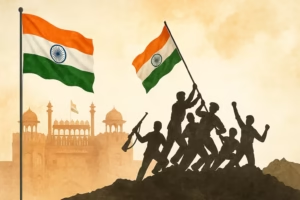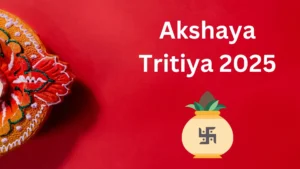Navratri: The 9 forms of Goddess Navdurga (Durga ), their significance, symbolism, and teachings. Learn rituals, values, and spiritual meaning.
Introduction
Navratri is an extremely important festival in Hinduism, dedicated to the worship of Goddess Durga. This festival spans over 9 days, during which the 9 forms of Goddess Durga, known as Navdurga, are worshipped. Each day is devoted to a specific form of the Goddess, and each form holds significant religious, symbolic, and life-affirming teachings. In this blog, we will explore the 9 forms of Navdurga and their profound significance.
At‑a‑Glance: Navdurga Quick Reference
| Day | Form | Aspect/Power | Iconography (Vahana • Hands/Weapons) | Beej Mantra (IAST / Devanagari) | Common Offering (Bhog)* | Spiritual Focus |
|---|---|---|---|---|---|---|
| 1 | Shailputri | Stability, roots, new beginnings | Bull (Nandi) • Trident & Lotus | Om Devi Śailaputryai Namah / ॐ देवी शैलपुत्र्यै नमः | Desi ghee | Grounding, resolve |
| 2 | Brahmacharini | Austerity, discipline | Barefoot ascetic • Rosary & Kamandalu | Om Devi Brahmacāriṇyai Namah / ॐ देवी ब्रह्मचारिण्यै नमः | Sugar/sherbet & fruits | Self‑control, tapas |
| 3 | Chandraghanta | Courage, protection | Lion • Ten arms, crescent bell | Om Devi Candrāghaṇṭāyai Namah / ॐ देवी चन्द्रघण्टायै नमः | Milk/kheer | Fearlessness, justice |
| 4 | Kushmanda | Creation, vitality | Lion • Eight hands, pot of nectar | Om Devi Kūṣmāṇḍāyai Namah / ॐ देवी कूष्माण्डायै नमः | Malpua/sweet dishes | Health, positivity |
| 5 | Skandamata | Motherhood, compassion | Lion • Holds child Skanda, lotus | Om Devi Skandamātāyai Namah / ॐ देवी स्कन्दमातायै नमः | Bananas | Family well‑being |
| 6 | Katyayani | Victory, righteous anger | Lion • Sword & Lotus | Om Devi Kātyāyanyai Namah / ॐ देवी कात्यायन्यै नमः | Honey | Overcoming obstacles |
| 7 | Kalaratri | Destruction of fear/evil | Donkey • Sword & Trident | Om Devi Kālarātryai Namah / ॐ देवी कालरात्र्यै नमः | Jaggery/gram | Protection, inner courage |
| 8 | Mahagauri | Purity, peace | Bull • Trident & Ḍamaru | Om Devi Mahāgauryai Namah / ॐ देवी महागौर्यै नमः | Coconut/sweets | Purification, serenity |
| 9 | Siddhidatri | Fulfillment, siddhis | Lotus seat • Discus, Mace, Lotus, Conch | Om Devi Siddhidātryai Namah / ॐ देवी सिद्धिदात्र्यै नमः | Sesame (til) | Success, spiritual gifts |
*Offerings vary by regional parampara (tradition); choose sattvic foods.
Shailputri (Day 1)
Goddess Shailputri is worshipped on the first day of Navratri. Her name is derived from the word Shail, which means mountain. Shailputri is considered the daughter of the Himalayas and is worshipped as Goddess Parvati. She represents stability and strength in life. Worshipping Shailputri provides mental peace, perseverance, and devotion. She rides a bull named Nandi, symbolizing power and righteousness, and holds a trident in her right hand and a lotus in her left.
Teaching: She reminds us to face life’s challenges with patience and determination, maintaining balance in all situations.
Mythic background: Revered as the rebirth of Sati as Parvati, the daughter of the Himalayas, Shailputri symbolizes the soul’s fresh start on the spiritual path.
Beej mantra: Om Devi Śailaputryai Namah (ॐ देवी शैलपुत्र्यै नमः)
Common offering: Desi ghee; light a pure ghee diya for steadiness.
Meditation focus: Ground the breath (mūlādhāra awareness) and set sankalp (intention) for the 9 days.
Brahmacharini (Day 2)
On the second day, Goddess Brahmacharini is worshipped. Her name comes from Brahma, meaning penance and meditation. She symbolizes austerity and spiritual focus. She holds a rosary in her right hand and a water pot in her left, dressed in white garments signifying serenity. Worshipping her instills courage, discipline, and perseverance.
Teaching: Discipline, self-restraint, and dedication are keys to achieving life’s goals.
Mythic background: As Parvati in deep tapasya, Brahmacharini embodies unwavering resolve that moves even the cosmos.
Beej mantra: Om Devi Brahmacāriṇyai Namah (ॐ देवी ब्रह्मचारिण्यै नमः)
Common offering: Sugar/sherbet (mishri) and fresh fruits.
Meditation focus: Japa with a rudrākṣa/ṭulsi mālā; cultivate mindful austerity.
Chandraghanta (Day 3)
Goddess Chandraghanta, worshipped on the third day, is adorned with a half-moon shaped bell on her forehead. She is the warrior goddess who destroys demons. She rides a lion, has ten arms with various weapons, and her fierce form ensures protection and strength. Worshipping her brings courage, fearlessness, and power.
Teaching: One must face challenges fearlessly, acting with courage and confidence on the path of righteousness.
Mythic background: After marrying Shiva, the Goddess assumes the Chandraghanta form—ever‑ready to protect dharma.
Beej mantra: Om Devi Candrāghaṇṭāyai Namah (ॐ देवी चन्द्रघण्टायै नमः)
Common offering: Milk, kheer, or milk sweets for inner calm.
Meditation focus: Visualize the protective crescent bell dispelling fear.
Kushmanda (Day 4)
On the fourth day, Goddess Kushmanda is worshipped. Her name means cosmic egg, as she is believed to have created the universe. She has eight hands holding weapons and nectar, rides a lion, and radiates positivity. Her worship brings health, prosperity, and energy.
Teaching: A positive outlook and recognition of inner strength can transform life.
Mythic background: The primordial spark who creates the universe, her smile is said to have formed the cosmic egg (anda).
Beej mantra: Om Devi Kūṣmāṇḍāyai Namah (ॐ देवी कूष्माण्डायै नमः)
Common offering: Malpua or sweet pumpkin preparations.
Meditation focus: Breathe into the navel center (maṇipūra) for vitality.
Skandamata (Day 5)
On the fifth day, Goddess Skandamata is worshipped, the mother of Lord Skanda (Kartikeya), commander of the divine army. Depicted riding a lion with her son on her lap, she symbolizes maternal love and compassion. Her blessings bring peace, prosperity, and well-being.
Teaching: Compassion, kindness, and nurturing are essential values for a righteous life.
Mythic background: Mother of Skanda (Kartikeya), commander of the divine hosts; she grants protection to families and children.
Beej mantra: Om Devi Skandamātāyai Namah (ॐ देवी स्कन्दमातायै नमः)
Common offering: Bananas and yellow flowers.
Meditation focus: Cultivate bhakti (devotional warmth) in the heart center.
Katyayani (Day 6)
Day six is dedicated to Goddess Katyayani, born to Sage Katya, also revered as Mahishasura Mardini. She rides a lion, holds a sword and lotus, and embodies triumph over evil. Worshipping her removes obstacles and grants victory.
Teaching: With her blessings, falsehood and unrighteousness can be defeated, ensuring success in both inner and outer battles.
Mythic background: Born in the lineage of Sage Katya, she is revered as Mahishasura Mardini, vanquisher of the buffalo demon.
Beej mantra: Om Devi Kātyāyanyai Namah (ॐ देवी कात्यायन्यै नमः)
Common offering: Honey (madhu) and saffron‑infused sweets.
Meditation focus: Sit with a straight spine; visualize cutting through inner obstacles with the sword of discernment.
Kalaratri (Day 7)
On the seventh day, Goddess Kalaratri is worshipped. Her dark, fierce form symbolizes the destroyer of fear and evil. She rides a donkey, holds a sword and trident, and provides fearlessness to devotees. Her worship removes negativity and calamities.
Teaching: Freedom from fear empowers us to walk the path of righteousness.
Mythic background: The fiercest form, Kalaratri devours darkness and protects seekers on perilous paths.
Beej mantra: Om Devi Kālarātryai Namah (ॐ देवी कालरात्र्यै नमः)
Common offering: Jaggery (gud) and roasted gram (chana).
Meditation focus: Slow, steady exhalations; release fear on each breath.
Mahagauri (Day 8)
Day eight honors Goddess Mahagauri, symbolizing purity and peace. Her white complexion and attire represent serenity and calmness. She rides a bull, has four hands, and holds a trident and damaru. Worshipping her brings prosperity, peace, and good fortune.
Teaching: True happiness is found in purity and tranquility of mind and soul.
Mythic background: After severe penance, the Goddess attains the radiant Mahagauri form, signifying purification.
Beej mantra: Om Devi Mahāgauryai Namah (ॐ देवी महागौर्यै नमः)
Common offering: Fresh coconut and kheer.
Meditation focus: Soften the gaze; invite peace to pervade thoughts and speech.
Siddhidatri (Day 9)
The ninth day is devoted to Goddess Siddhidatri, who grants all siddhis (spiritual powers). Sitting on a lotus with four hands, she blesses devotees with success in both spiritual and material pursuits.
Teaching: Walking the path of truth and dharma leads to success and spiritual progress.
Mythic background: Bestower of all siddhis, she is said to have granted powers to Shiva himself (Ardhanārīśvara lore).
Beej mantra: Om Devi Siddhidātryai Namah (ॐ देवी सिद्धिदात्र्यै नमः)
Common offering: Sesame (til) and sweet dishes; offer gratitude for completed sādhanā.
Meditation focus: Contemplate your highest aim; visualize its graceful completion.
General Puja Vidhi (Daily Outline)
- Sankalp & Shuddhi: Purify the space, bathe, wear clean/sattvic clothes; take a sankalp for 9 days.
- Altar Setup: Place Durga image/idol; kalash with mango leaves & coconut; red cloth, flowers, and diya.
- Invocation: Ganesha vandana → Durga dhyāna → relevant Navdurga beej mantra (108, 51, or 11 counts as per capacity).
- Offerings: Pushpa (flowers), dhoop, deep, naivedya (sattvic), water; read stotra (e.g., Durga Saptashati passages if practiced).
- Aarti & Prarthana: Perform aarti; pray for strength, purity, and wisdom.
- Seva & Dāna: Practice kindness, avoid harm, and offer charity.
Note: Puja timings and rules vary by region/gotra/panchang. Consult a trusted local panchang for exact tithi and muhurat.
FAQs (Short Answers)
Q1. Are the Navratri colors fixed every year?
Colors are mapped to weekdays and can change annually. Follow your regional list for the current year.
Q2. Is strict fasting mandatory?
No. Many observe fruit‑only or light sattvic diets; health and intention take precedence.
Q3. Can beginners chant these mantras?
Yes. The listed beej mantras are short and suitable for daily japa.
Q4. What if I miss a day?
Offer sincere prayer the next day; consistency matters more than perfection.
Q5. Chaitra vs Sharad Navratri—what’s the difference?
Both worship Navdurga; Chaitra occurs in spring, Sharad in autumn; customs are similar with regional variations.
The worship of the nine forms of Navdurga during Navratri is not only religiously significant but also serves as a guide for living a meaningful life. Each form of Goddess Durga imparts unique teachings, from strength and discipline to compassion, fearlessness, and spiritual fulfillment. Navratri inspires us to embrace righteousness and spirituality, empowering us to overcome life’s challenges with grace.
Read this in Hindi (हिंदी में पढ़ें) → [click here]
Related Reading: Durga Ashtami, Dussehra (Vijayadashami), Chaitra Navratri Guide .
Last Updated on September 16, 2025 by Hinditerminal.com



